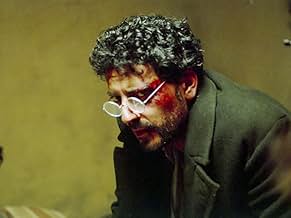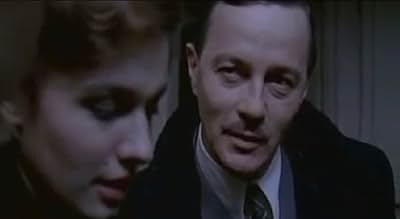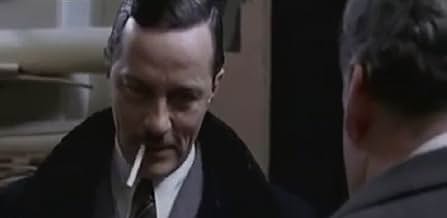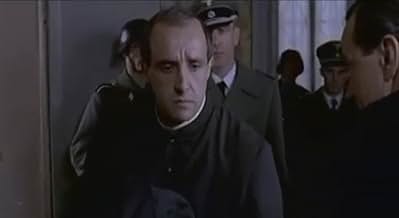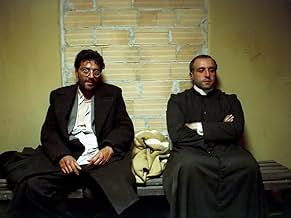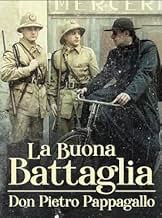Ajouter une intrigue dans votre langueCatholic priest Pietro Pappagallo, a member of the Italian resistance, is executed in the Ardeatine caves.Catholic priest Pietro Pappagallo, a member of the Italian resistance, is executed in the Ardeatine caves.Catholic priest Pietro Pappagallo, a member of the Italian resistance, is executed in the Ardeatine caves.
- Prix
- 2 victoires au total
Monica Comegna
- Luisa
- (as Monica Carmen Comegna)
Histoire
Le saviez-vous
- AnecdotesFinal film of Marisa Merlini.
Commentaire en vedette
INTRODUCTION: I must first point out that this film is definitely NOT recommended for children under the age of 12, due to some adult themes, language and graphic violence. It's a shame that this film is not available on DVD.
CAST: Flavio Insinna definitely deserved an award for his roll as Don Pietro, an Italian priest who opens his home as a refuge to people seeking asylum from the Nazi regime. Romanian-born actress Ana Caterina Morariu plays Lidia, a young woman whose father and brother, Gino, an Italian soldier are killed by the Nazis. Paolo Briguglia plays Mario, an injured Italian soldier, who, along with Lidia, seek refuge in Don Pietro's home. Ignazio Oliva plays Prof. Gioacchino, a former student of Don Pietro's, and is the leader of the Resistance, an armed group of people who help the captured flee the Nazi regime. Vanni Corbellini plays Dr. Koch, a Jewish physician, who cares for the people staying in Don Pietro's home. Paola Tiziana Cruciani excellently plays Teresa, a no-nonsense housekeeper who feeds anyone who shows up on Don Pietro's doorstep, and Don Pietro affectionately calls her a "saintly woman". Max Mazzott plays Oscar, an informant for Don Pietro.
PART I: Don Pietro gives a 5-year-old boy money for attempting to read the Ordinance sign posted on a wall outside a store. On a bus trip, Don Pietro tries to keep a widow with a baby boy, and Dr. Koch from being separated after having to get off at a Nazi roadblock. Don Pietro then thanks the Nazi soldier in Spanish. Now I don't know if this was part of the script, Flavio ad-libbing or an editorial oversight. A young woman, Luisa, is shot as she and the other Resistance members help some captives flee from the Nazi truck. She then is brought to Don Pietro's house to recover. When she is well enough to leave, Don Pietro suggests she hide a pillow inside her skirt, to make her look like she's pregnant. Don Pietro escorts her past the Nazi guards into an ambulance leaving Rome. In the final scene of Part I, Don Pietro helps a Jewish man by trying to bike-ride him to his home. He stops when he sees some Resistance men running by dropping spiked nails on the road. He and the old man hide behind a wall. After the truck runs over the nail, and the tires flatten, some of the captives decide to escape. When he sees a Nazi soldier fire at an escapee, he runs out to shield the man, but the man dies in his arms. Don Pietro's face is full of pain and anguish, as the scene slowly fades from color to black and white.
PART II: Don Pietro takes Lidia back to her late father's office to look for important documents. She gives Don Pietro a document to take to a typographer, who's actually a Nazi sympathizer. Don Pietro gives a toy truck to the professor's young son, Rocco. It's Christmas 1943. Everyone gathers at Don Pietro's house for Christmas Eve dinner. Oscar leaves a bottle of wine at Don Pietro's doorstep, but won't come in. This is the start of a pattern when he starts to betray Don Pietro, like Judas betrayed Jesus. New Year's Day 1944 arrives. The professor gives Don Pietro bad news. The Nazis are starting to close in, and that everyone staying at Don Pietro's house need to escape. Walking home that night, the professor is arrested by the Nazis. The next day, Don Pietro tells everyone that they need to leave. Oscar leads the Nazis to Don Pietro's home. They force their way into the apartment. Teresa's trying to run upstairs warning Don Pietro that the Nazis have arrived, but is held back. The Nazi soldiers force their way into his apartment as Don Pietro's arrested and hauled off to jail. He's then interrogated and tortured. Oscar refuses the reward money that the Nazis have offered him. Two resistance men finally catch up with Oscar and give him what he finally deserves. At the urging of his cell mates, Don Pietro celebrates mass and offers them their final meal before execution. The day is March 24, 1944. The Nazi soldiers then come in and escort Don Pietro and 3 other men for execution. Their hands are tied behind their backs as they're being led into trucks bound for the execution site. There's a crowd of crying people seeing their loved ones being led off. Don Pietro says a tearful goodbye to the professor as they're being loaded into separate trucks. Don Pietro whispers his final prayer before being executed.
CONCLUSION: This was very well directed by Gianfranco Albano. The music is very solemn, and the cinematography is excellent. In one scene, as the young widow tells everyone her story, the camera's point of view slowly backs out. If there ever was a war hero, it would have to be Don Pietro Pappagallo. At one time, Pope John Paul II, called Don Pietro a martyr and a saint. I highly believe that Don Pietro should be canonized as a saint, and hopefully, Pope Benedict will push for sainthood for Don Pietro Pappagallo.
CAST: Flavio Insinna definitely deserved an award for his roll as Don Pietro, an Italian priest who opens his home as a refuge to people seeking asylum from the Nazi regime. Romanian-born actress Ana Caterina Morariu plays Lidia, a young woman whose father and brother, Gino, an Italian soldier are killed by the Nazis. Paolo Briguglia plays Mario, an injured Italian soldier, who, along with Lidia, seek refuge in Don Pietro's home. Ignazio Oliva plays Prof. Gioacchino, a former student of Don Pietro's, and is the leader of the Resistance, an armed group of people who help the captured flee the Nazi regime. Vanni Corbellini plays Dr. Koch, a Jewish physician, who cares for the people staying in Don Pietro's home. Paola Tiziana Cruciani excellently plays Teresa, a no-nonsense housekeeper who feeds anyone who shows up on Don Pietro's doorstep, and Don Pietro affectionately calls her a "saintly woman". Max Mazzott plays Oscar, an informant for Don Pietro.
PART I: Don Pietro gives a 5-year-old boy money for attempting to read the Ordinance sign posted on a wall outside a store. On a bus trip, Don Pietro tries to keep a widow with a baby boy, and Dr. Koch from being separated after having to get off at a Nazi roadblock. Don Pietro then thanks the Nazi soldier in Spanish. Now I don't know if this was part of the script, Flavio ad-libbing or an editorial oversight. A young woman, Luisa, is shot as she and the other Resistance members help some captives flee from the Nazi truck. She then is brought to Don Pietro's house to recover. When she is well enough to leave, Don Pietro suggests she hide a pillow inside her skirt, to make her look like she's pregnant. Don Pietro escorts her past the Nazi guards into an ambulance leaving Rome. In the final scene of Part I, Don Pietro helps a Jewish man by trying to bike-ride him to his home. He stops when he sees some Resistance men running by dropping spiked nails on the road. He and the old man hide behind a wall. After the truck runs over the nail, and the tires flatten, some of the captives decide to escape. When he sees a Nazi soldier fire at an escapee, he runs out to shield the man, but the man dies in his arms. Don Pietro's face is full of pain and anguish, as the scene slowly fades from color to black and white.
PART II: Don Pietro takes Lidia back to her late father's office to look for important documents. She gives Don Pietro a document to take to a typographer, who's actually a Nazi sympathizer. Don Pietro gives a toy truck to the professor's young son, Rocco. It's Christmas 1943. Everyone gathers at Don Pietro's house for Christmas Eve dinner. Oscar leaves a bottle of wine at Don Pietro's doorstep, but won't come in. This is the start of a pattern when he starts to betray Don Pietro, like Judas betrayed Jesus. New Year's Day 1944 arrives. The professor gives Don Pietro bad news. The Nazis are starting to close in, and that everyone staying at Don Pietro's house need to escape. Walking home that night, the professor is arrested by the Nazis. The next day, Don Pietro tells everyone that they need to leave. Oscar leads the Nazis to Don Pietro's home. They force their way into the apartment. Teresa's trying to run upstairs warning Don Pietro that the Nazis have arrived, but is held back. The Nazi soldiers force their way into his apartment as Don Pietro's arrested and hauled off to jail. He's then interrogated and tortured. Oscar refuses the reward money that the Nazis have offered him. Two resistance men finally catch up with Oscar and give him what he finally deserves. At the urging of his cell mates, Don Pietro celebrates mass and offers them their final meal before execution. The day is March 24, 1944. The Nazi soldiers then come in and escort Don Pietro and 3 other men for execution. Their hands are tied behind their backs as they're being led into trucks bound for the execution site. There's a crowd of crying people seeing their loved ones being led off. Don Pietro says a tearful goodbye to the professor as they're being loaded into separate trucks. Don Pietro whispers his final prayer before being executed.
CONCLUSION: This was very well directed by Gianfranco Albano. The music is very solemn, and the cinematography is excellent. In one scene, as the young widow tells everyone her story, the camera's point of view slowly backs out. If there ever was a war hero, it would have to be Don Pietro Pappagallo. At one time, Pope John Paul II, called Don Pietro a martyr and a saint. I highly believe that Don Pietro should be canonized as a saint, and hopefully, Pope Benedict will push for sainthood for Don Pietro Pappagallo.
- mistymountain
- 3 avr. 2008
- Lien permanent
Meilleurs choix
Connectez-vous pour évaluer et surveiller les recommandations personnalisées
Détails
- Durée3 heures 20 minutes
- Couleur
Contribuer à cette page
Suggérer une modification ou ajouter du contenu manquant

Lacune principale
What is the Spanish language plot outline for La buona battaglia - Don Pietro Pappagallo (2006)?
Répondre
